Disclosure: Meeple Mountain received a free copy of this product in exchange for an honest, unbiased review. This review is not intended to be an endorsement.
In Soulgivers, two opposing groups of souls lurk in the ether of space. Each of these factions is desperate to retrieve the pulsing, shimmering Fragment: a mysterious power that will stop their people’s decay and return them to their immortal lives.
I could keep going — the rulebook starts with a three page short story describing the lore — but underneath all its glitter and chrome, Soulgivers is an abstract game at heart. This may be because of its minimalist design or may be a natural consequence of how the game works.
How the Game Works
Soulgivers is a two-player game of tactical movement and deterministic combat. Both players control a team of units called Soulgivers, each with their own unique powers and abilities. Both players are racing to retrieve a piece called the Fragment and bring it back to their home territory. The first team that can get the Fragment all the way home wins. Design-wise, Soulgivers shares a lot of DNA with Capture the Flag.
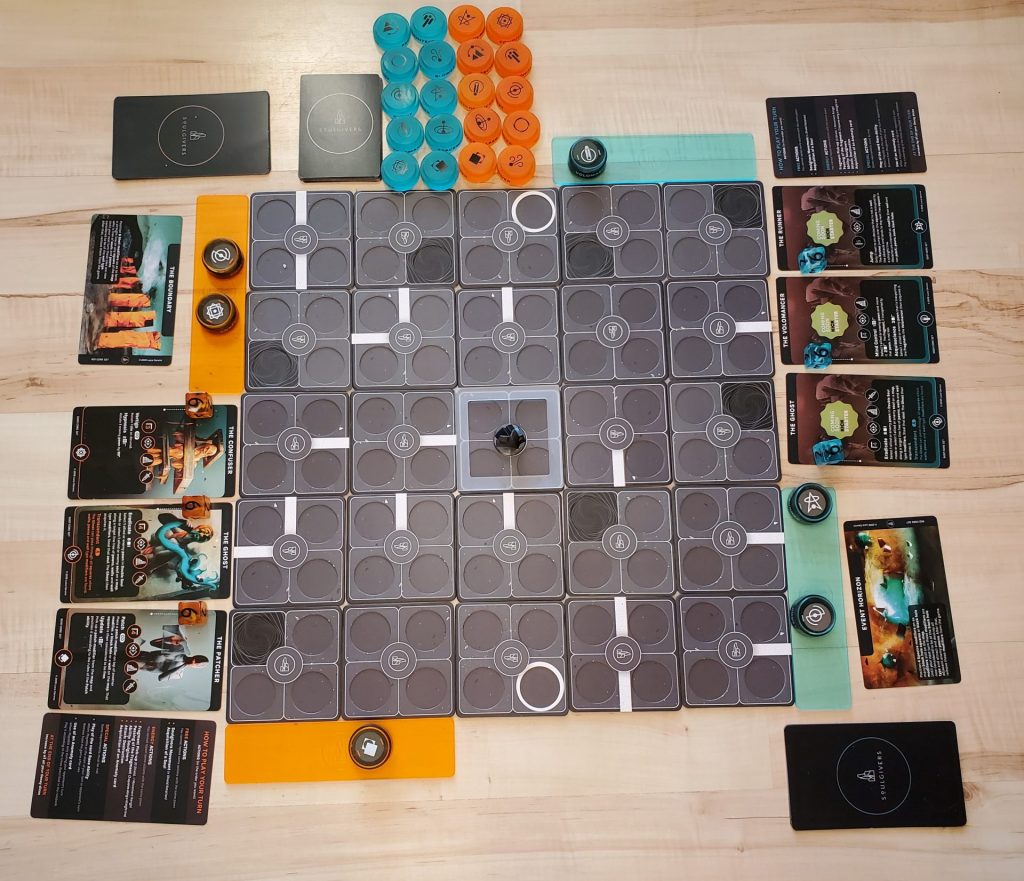
The game is played on a grid, with the Fragment starting in the center. Each team has two places to enter the board called Portals (blue and orange), which is also where players must bring the Fragment to win. The Portals matter beyond just the start of the game: each player will only have three Soulgivers on the board at any time, and when one dies, a new one is drawn and enters from the Portal of the player’s choosing.
On your turn, you’re allowed to move all of your Soulgivers and perform a handful of actions.
Soulgivers and movement: Soulgivers have special rules for their movement and powers, with each Soulgiver represented by a token on the board and a reference card in front of the player. As a general rule, Soulgivers can move in a straight line or a series of adjacent steps, up to a maximum number printed on the reference card. The reference card also outlines the rules for the Soulgivers’ movement, their special abilities, and whether or not they’re able to attack.

Actions: Most actions in the game are performed by Soulgivers and most require a Tribute. Every turn, players have three Tribute Essence tokens which they can distribute across their Soulgivers as they like. This is a handy way of remembering how much you’ve done; between moving Soulgivers and acting with them, you could find yourself a little mixed-up without these tokens to track things.
So what kind of actions can Soulgivers perform? There are a few:
- Fragment Pick-up: If your Soulgiver is on the same tile as the Fragment, you can pick it up. Soulgivers carrying the Fragment have a lower movement range and no protection from enemy pieces, so this is a risky (but necessary) move.
- Passing of the Fragment: To help hurry the Fragment back to your Portal, you can pass it like a football — as an action, the active Soulgiver can chuck the Fragment to another Soulgiver exactly three spaces away.
- Abilities: Each Soulgiver has at least one Ability unique to them. Most of these Abilities cost an action (tribute), and can be anything from stealing the fragment to rearranging the tiles that make up the board.
- Attack: Destruction: Combat in Soulgivers is pretty straightforward. When directly adjacent to an enemy Soulgiver, a Soulgiver with the Attack: Destruction Ability can destroy the opponent’s piece. There is a defence mechanism, though: each Soulgiver token is shielded from attack on at least one side. Clever positioning can prevent an attack from taking place before it happens.
- Acquisition of an Anomaly Card: This is the only action not performed by a Soulgiver. A player can spend one of their Tribute Essence tokens to draw an Anomaly Card. These cards add a little unpredictability to the game and are played during the opponent’s turn to mess with their plans.
You can use all three of your actions on one Soulgiver or budget them carefully among all your units. The only restriction, really, is that you can’t perform the exact same action with the same Soulgiver on the same turn — for example, you’re not allowed to attack twice with the same unit. To keep things manageable, each Soulgiver’s movement and actions are resolved completely before you move onto the next one.
You’re likely to see a number of Soulgivers in any given game, partly because of a built-in countdown. When a Soulgiver enters play, they come with a six-turn timer. When the timer runs out, the Soulgiver “decays” and is removed from play. When a Soulgiver dies (through decay or attack), a new one enters the board from one of the player’s Portals.
Players take turns back and forth until the game ends. That happens when someone gets the Fragment home, or when neither player can win… a situation that generally happens when players run out of Soulgivers.
Flourishes in Soulgivers
There’s a lot of little touches that make Soulgivers stand out… little touches that didn’t really need to be a part of the game, but are an obvious product of intentional design. Here are a few:
- Modular board: Soulgivers’ board is made up of a series of tiles and will vary from game to game. Each tile has obstacles for the units to navigate and strategize around, which helps with the game’s replayability.
- Small balance considerations: It can be hard to make a game that allows for big dramatic moments and also feels fair. Soulgivers has a couple of small touches that help to make that dream come true. One example is the barrier that surrounds the Fragment at the start of the game, requiring an attack to dismantle and keeping the first player advantage from becoming too much. Another is the space on the board that, when occupied, can block the other player from playing Anomaly cards against you. Small considerations like these (and others that would require more elaborate explanation) show the game’s intentional design.
- Perfect notches for the Fragment: The Fragment is a pretty big piece, which it should be; it acts as the focal point of the game. To make everything fit together, the designer has made units stackable: the Fragment is magnetized and snaps onto your base unit when carried. This also cleverly covers up your unit’s shield information, showing that they’re vulnerable when burdened with the Fragment. There’s even a perfect little hole in the center of each tile for the Fragment to sit. The designers have taken steps not only to make the Fragment a big, imposing flag, but also to nestle it into the game’s infrastructure in a way that feels natural.
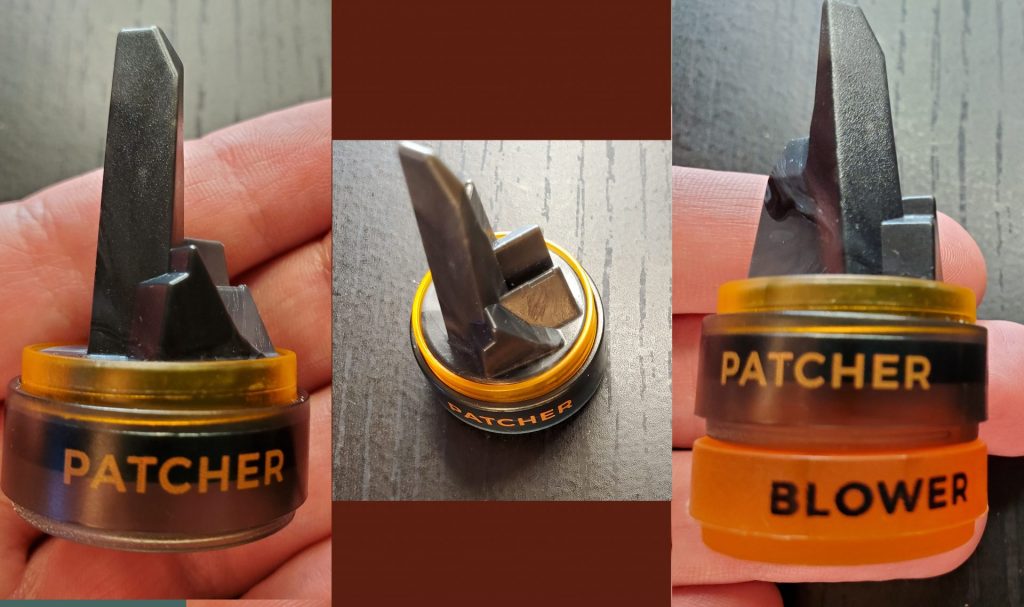
All of these decisions make sense, given the designer’s pedigree: while Soulgivers is Luca Cervini’s first published design, his professional background in art and design shine through in all the little details Soulgivers brings to the table.
Final Thoughts
So, that’s how Soulgivers works and a little of what’s under the hood. I’ll end this review with a few observations that shaped my opinion of the game.
Aesthetic: I’ll start with the obvious here: Soulgivers is visually stunning. Abstract and low-luck games have to do a lot to stand out in today’s market — a point I discuss in more detail in my review of the beautiful SHŌBU. Soulgivers manages to hit the mark on every aspect of its aesthetic design. The gorgeous card art feels organic and geometric, flowing and concrete, with a unique style that makes the game pop. The game pieces, matte and vibrant, are both beautiful and legible. The board is an easy-to-read space that still manages to look sleek and put-together. It’s extremely clear that this game was a labour of love. (All that being said, I played with a prototype copy; I don’t know what the final manufactured product will look like, but I’m encouraged by what I’ve seen so far.)
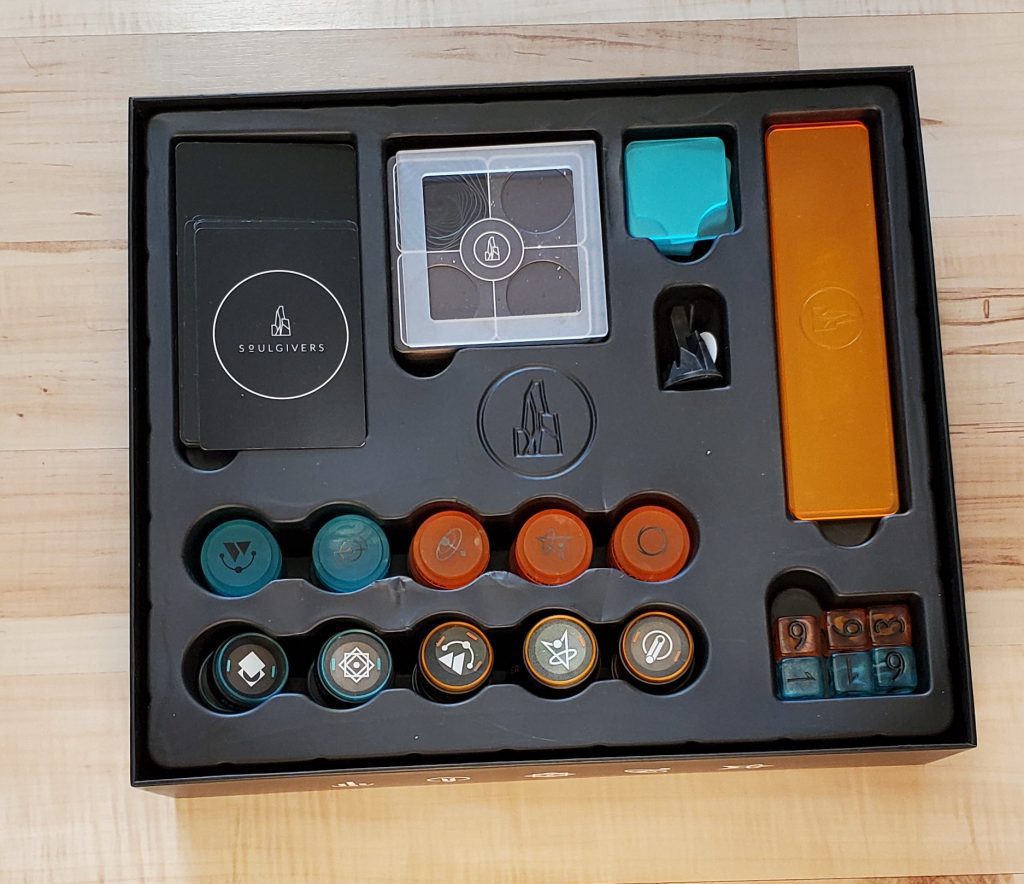
Lots of moving pieces: What follows is something you may already have picked up on from this review or the rules themselves: Soulgivers is a lot to take in. While the pieces all fit together well, this is much less Chess and much more Neuroshima Hex. The game is peppered with little rules, one-time powers, and units whose abilities you’ll need to understand before you can really grasp the overall strategy. I skimmed over a few concepts in this review, and there’s several more things that I skipped altogether. The rules feel intentional and well-integrated, but the game will suffer in the eyes of some players because of its complexity.
Expansion dreams: From the structure of the game and the phrasing of the Kickstarter, it’s pretty clear that Soulgivers is intended to be a franchise. With factions that can be swapped out at will for new and exciting combinations, Soulgivers is set up perfectly for a whole line of releases, each with a new set of pieces and cards. Of course, it’s still early days for the game: it remains to be seen if the company can generate the capital necessary to realize their franchise, or if they will go the way of the ill-fated Tash-Kalar: Arena of Legends. But regardless of how things shake out, what comes in the Soulgivers box is a successful game on its own.
Ties and losses: One small point of contention for me was the victory system. Most games, I suspect, end in an unambiguous victory when one faction gets the Fragment home. But the rules are not so simple. The game has edge-case endings for situations where all Soulgivers are lost, and these situations involve a series of if-then statements. To make a long story short, there’s a somewhat inelegant system of ties and losses that can happen when neither player is in a position to win. I don’t love the distinction the game makes, but folks more comfortable with a fight for stalemate may have no problem with these niche ending conditions.
Game length: I love a good head-to-head battle. There’s something really exciting about outmaneuvering a single opponent, and the tactical choices in Soulgivers lead to an interesting back-and-forth. In spite of this, I found that I wouldn’t have minded if the game ended a little earlier. While I enjoy the tug-of-war baked into the gameplay, a shorter variant would have been nice for busier evenings.
In summary: Soulgivers is a vibrant game with a strong idea and a unique execution. It wasn’t the perfect game for me — if I’ve learned anything from reviewing this, it’s that I lean towards a more pared-down experience when I’m looking for a head-to-head game. Still, Soulgivers impressed me, and I’m glad I got the chance to explore it.
The Kickstarter ended last month, but you can still pre-order the game at their website or play it on Tabletopia.
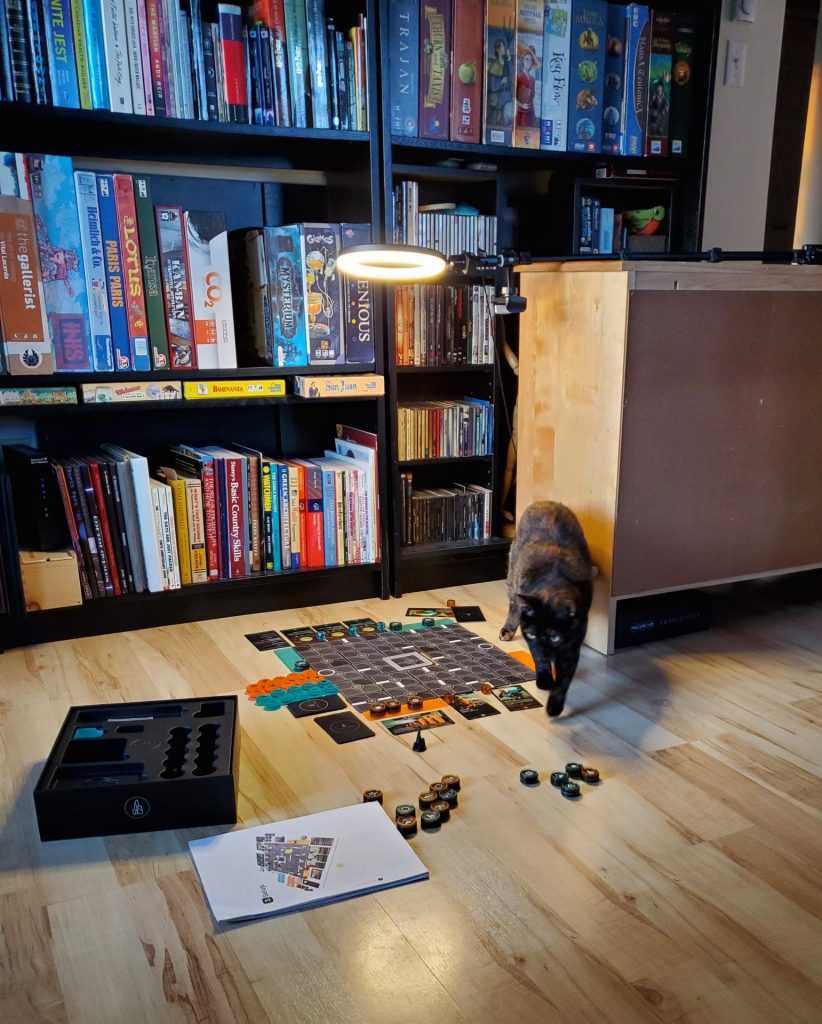






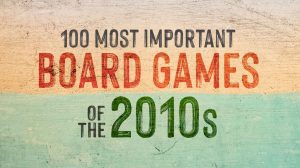




This looks amazing! Thanks for the review (this is a game that was not on my radar in any way!). I am excited to pre-order this.
I hadn’t heard about it until the publisher reached out to us, actually. My reaction was pretty much the same as yours, haha. 🙂 Thanks for reading, Kenneth.